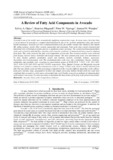| dc.description.abstract | Avocado is one of the world's most economically significant tropical fruit crops. In recent years, there has been a lot of interest in avocado as a natural functional food in due to its excellent nutritional value and several health advantages. Avocados are rich in unsaturated fatty acids, fat-soluble vitamins like vitamin E and vitamin B6, alpha-carotene, sterols, fiber, protein, magnesium and potassium. Fatty acids play crucial structural and functional roles in biological systems and are a significant source of energy. The essential polyunsaturated fatty acids such as linoleic acid and the α-linolenic acid cannot be synthesize by human body hence must be obtained from food. This study reviewed the fatty acid composition of avocado. Peer-reviewed articles were retrieved from Scopus, Science Direct, SciFinder and Google Scholar. The most common fatty acids were determined to be oleic, linoleic, palmitic, palmitoleic, stearic and linolenic, myristic, arachidic, behenic, eicosenoic, myristoleic and tetraeicosanoic acid. The predominant fatty acids were oleic, palmitoleic, linoleic, linolenic, palmitoleic and arachidic acid, occurring in concentration ranges of 10.88-74.32, 7.70-55, 5.25- 38.2, 0.03- 24.17, 0.16-19.78, 0.45-18.55 and 0.07-10.95% respectively. Hass, Quintal, Fortuna and Margarida avocado cultivars were found to contain docosahexaenoic acid, an omega-3 amino acid which is mainly obtained from fish. The type of fatty acids and their percentage composition in the avocados differed depending on the cultivar, plant part, ripening stage, geographical location and sample processing method. Results from this study have confirmed that avocado is a rich source of essential fatty acid. Further research on methods of enhancing fatty acid content is necessary. It is also necessary to determine the bioactivities of the fatty acids present in avocado. | en_US |

